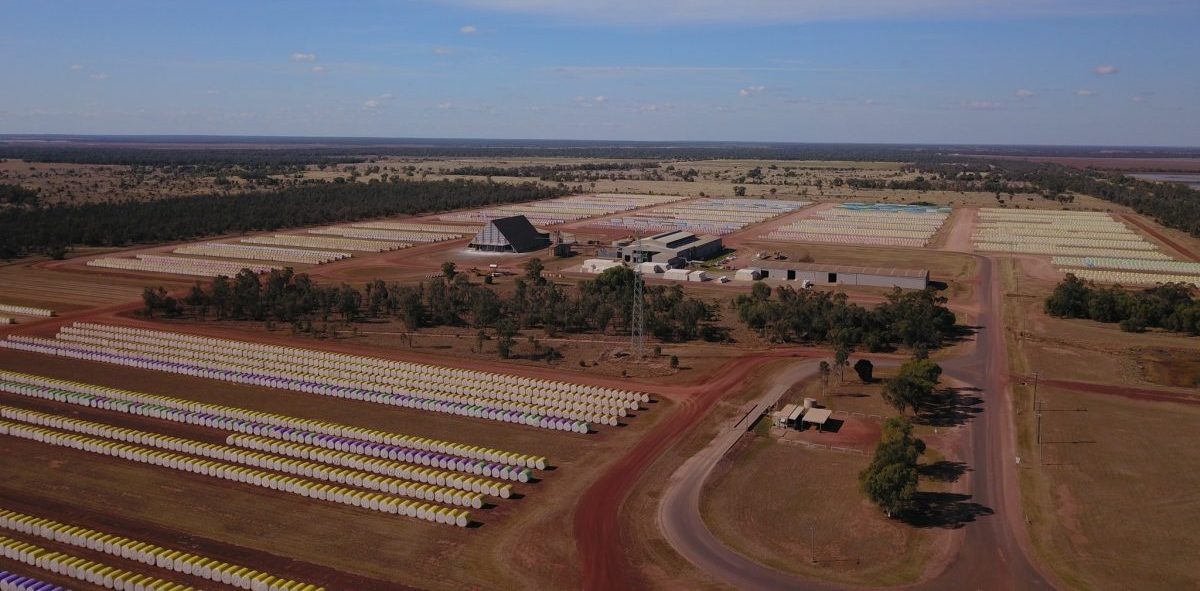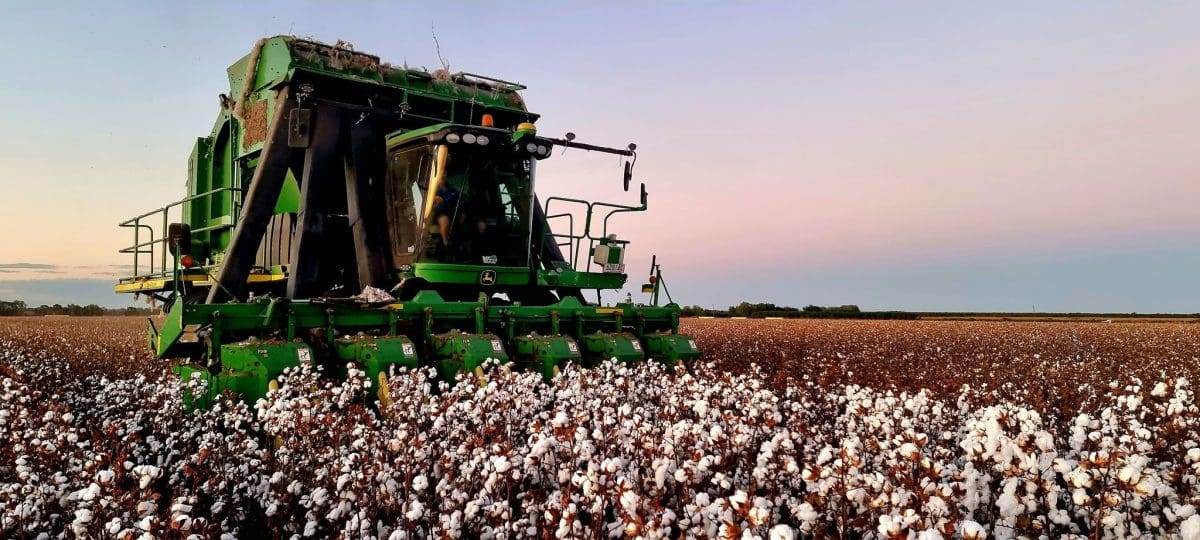
Beardmore gin in south-west Qld with a full yard. Photo: Queensland Cotton
PICKING of eastern Australia’s cotton crop in all regions bar southern New South Wales is nearing conclusion, and volume could well nudge the record set by last year’s crop.
ABARES on June 6 estimated the Australian cotton crop at 5.5 million bales, or 1,252,000 tonnes of lint, in line with Cotton Australia’s estimate.
This is down slightly from the record 5.6Mb produced last year, and is up from 5.3Mb forecast in ABARES previous current-crop estimate released in March.
“The yields are better than expected from the Macquarie Valley North and the quality is very pleasing,” a Cotton Australia spokesperson said.
“Southern NSW growers are still dealing with challenging conditions.”
The peak grower organisation on Friday estimated the crop was around 85 percent picked.
Slow start for marketing
In ABARES June Commodities Quarterly, global cotton production for 2023-24 was forecast at 116Mb, and world cotton demand was seen as being constrained by the weak economic outlook and inflationary pressure.
“Demand is unlikely to rise markedly until economic conditions and discretionary spending in the United States and the European Union improve,” the report states.
For Australia, the slow start to ginning and concerns about inflationary pressure tempering global demand for yarn have made for a lacklustre start to export sales for the current crop
RainAg director Ian Grellman said the market has been loath to commit to early-season sales for fear of limited volume ex gins in the front months of the marketing year, and global concerns in this inflationary cycle.
“Normally when you sell cotton early in the season, there’s a premium for stuff that’s prompt,” Mr Grellman said.
“It’s a bit hard to move; it’s not like it’s running off the shelf.”
Mr Grellman said merchant interest appeared to be picking up now that cotton was coming through the supply chain at pace.
“They’re trying to buy later bales.”
Despite its highly variable yields, Mr Grellman said the crop now being ginned could well be a record.
“The yields are anywhere from 8 bales a hectare to 19 bales, so they’re well and truly all over the shop.”
He said most cotton has been good or better quality.
“There’s a lots of 21s, and some 11s; the colour looks unreal, but there are some issues with micronaire…the south has some big issues with low mike, and north has some issues with high mike.”
With China still out of the picture, the bulk of Australia’s cotton is expected to go to Indonesia, Thailand and Vietnam.
Potential exists for some volume to go to South Asia and beyond as containers return to more affordable and reliable levels.
“We will have markets start working that weren’t working last year or the year before; we didn’t do a lot then to South Asia because of container rates.”
Namoi Cotton lead account manager for the Border Rivers region, Owen Webb, said the supply chain, as well as subdued global demand, has had an effect on early sales.
“The offshore market has been sluggish, and that’s an effect of where the economy is globally,” Mr Webb said.
“We’ve had a period for over six months where central banks have been consistently raising interest rates to snuff out of inflation.
“Mills aren’t probably at full production, and they’re not buying at full pace.”
CQ picking well past half way
Queensland Cotton has two gins in Central Qld — Emerald and Moura — with Moura being one of the first to start up for the season in late March, and Emerald getting off to a late start last month.
Queensland Cotton’s CQ regional manager Rick Jones said ginning will run through until late October or early November.
“Picking is roughly 60pc done, and ginning around 20pc,” Mr Jones said
He said picking was still under way in the Dawson-Callide region, which feeds the Moura gin.
“With dry picking conditions, growers are getting close to 80pc picked; the gin yard in Moura is very full, and the gin is roughly halfway through ginning.
“It was a slightly later start to ginning this season starting towards the end of March and ginning should finish around late September.
“It’s a similar story in Emerald with dry picking conditions, but due to no irrigation allocation to plant early in the season, planting was delayed which has meant a later start to picking for the bulk of the crop.”

Picking cotton in CQ last month, where late planting due to irrigation allocations becoming available in November are making for a late finish to picking. Photo: Renee Anderson
Macintyre in final week
Mr Webb said growers have had an “absolutely fantastic run”, and as of last week, the region was around 95pc picked.
“By the time we get to the end of this week, we should be close to 100pc picked.”
The Macintyre’s crop was generally planted 2-3 weeks later than normal, and in mild conditions, and Mr Webb said this, as well as some hurried ground preparation caused by rain delays and the late winter crop, have shown up in some yields.
“Yields have been up and down, and the gin average for irrigated cotton is over 13b/ha, which is a fairly good result given a fair few challenges.”
He said Namoi’s twin Macintyre gins at Goondiwindi were expected to break their record of 296,000b set in 2012.
“We’re on track to have record volume in excess of 300,000 bales.”
He said short staple length has downgraded some dryland cotton, but irrigated crops have been of a uniformly high standard.
“We’re seeing a lot of premium colour come through.”
Mr Webb said ginning was expected to run through to mid-October.
“We’re running two months later than normal due to the volume.”
Sluggish in south
In southern NSW, RivCott’s gin was the first of the region’s four to get going, and chief executive officer Sam Buster said that was one month later than the normal late April-early May start-up.
“The growers have had a really rough year,” Mr Buster said.
“While they had intentions of planting a large, early and successful crop, it rained almost non-stop in the main planting window in October and November for six weeks.”
He said the crop started wet, late and cold, and the upshot of poor seedling vigour was now being seen.
“When you lose seedling vigour, you lose yield potential.
“Yield looks to be down by about 3b/ha; last year our average was 10.6 bales, this year it’s going to be more like 7.7 bales.”
Mr Buster said the problematic planting window meant growers generally only planted half to two-thirds of intended area.
He said low micronaire looked like being responsible for discounts on around 35pc of the cotton coming into the gin.
“In good years, low mike’s not there at all.”
However, Mr Buster said length and strength have been good, but the flow of bales into the yard has been fitful.
“Even now we’re struggling to get cotton in with constant rain showers.”
Grain Central: Get our free news straight to your inbox – Click here

HAVE YOUR SAY